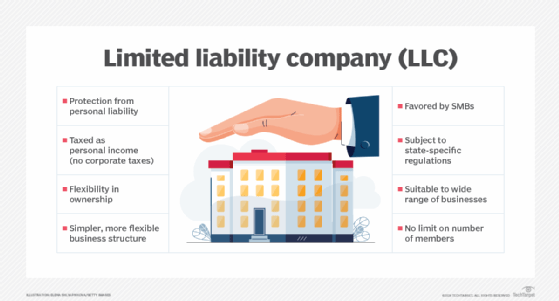limited liability company (LLC)
What is a limited liability company (LLC)?
A limited liability company (LLC) is a business structure in the United States that provides its owners with limited liability protection while allowing the flexibility of being taxed as a partnership or sole proprietorship.
An LLC is a versatile business structure in that it incorporates elements of both traditional corporations and partnerships. It shields its owners, known as members, from personal liability in most instances, meaning personal assets like houses, cars and savings accounts can't be seized to collect business debts.
However, it still allows for the business profits and losses to pass through to members' personal income without facing corporate taxes.
LLC members and ownership
An LLC can have one or more owners; there is no upper limit on the number of members. Individuals, corporations, other LLCs or foreign entities can be members. The flexibility in ownership allows LLCs to be a suitable option for a wide range of businesses.
To form an LLC, one must file articles of organization with the state's Secretary of State office or similar government body. This process involves submitting a document that outlines a business plan and essential details about the LLC, including its name, principal office and the contact information for its registered agent.
Taxation of LLCs
Typically, LLCs benefit from pass-through taxation where instead of the company itself being taxed, the profits and losses are passed on to the members and reported on their personal tax returns. This method helps LLCs avoid the double taxation corporations normally experience.
Legal protection and limitations of LLCs
LLCs provide their members with protection from personal liability for business decisions or actions of the LLC. This protection is similar to what corporate shareholders enjoy but is available in a simpler and more flexible business structure that is easier to maintain.
While an LLC does protect personal assets, it does not shield members from their own misconduct or professional malpractice. Additionally, LLCs might have more limited options for raising capital compared to corporations that can issue shares of stock.

Regulatory requirements for LLCs
LLCs are subject to state-specific regulations that might require annual reports, filing fees and other compliance measures to maintain good standing legally. LLCs must adhere to these regulations to avoid penalties or dissolution.
LLCs abroad
While the LLC is a popular form in the United States, similar structures exist internationally, often known as private limited companies. These entities share many of the characteristics of LLCs but are subject to the legal and tax regulations of their respective countries.
In summary, limited liability companies offer a flexible, efficient structure for business owners looking to minimize their personal liability while enjoying the benefits of pass-through taxation. They are particularly favored by small to medium-sized businesses for their simplicity and effectiveness in protecting personal assets while avoiding the double taxation of corporations.
Avoiding business problems and operating effectively require companies to be ready to cope with common risks. Read about 13 types of business risks for companies to manage.
